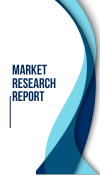
Biologics Market - Global Industry, Analysis, Size, Share, Growth, Trends, and Forecasts 2023-2030
- Category: Healthcare
- Report ID: CMR15625
- Upcoming
Biologics are the biological drug product that is produced from living organism or contain components of living organisms. Biologic drugs include a wide variety of products derived from humans, animals, or microorganisms by using biotechnology. Types of biologics include vaccines, blood components, cells, allergens, genes, tissues, and recombinant proteins. Biologic products may contain proteins that control the action of other proteins and cellular processes, genes that control the production of vital proteins, modified human hormones, or cells that produce substances that suppress or activate components of the immune system. Biologics are sometimes referred to as biologic response modifiers because they change the manner of operation of natural biological intracellular and cellular actions.
Biologic drugs are used for the treatment of numerous diseases and conditions and are the most advanced therapies available. Some biologic drugs are used for the treatment of Crohn’s disease, ulcerative colitis, rheumatoid arthritis, and other autoimmune disease. Available biologics have revolutionized cancer treatment, delayed or reversed the course of immune-related conditions, changed the lives of people with rare diseases, and offered hope for many patients who previously had no effective treatment options for their condition. The production of biologics involves advanced techniques like genetic engineering, cell culture, and recombinant DNA technology. Typically, these processes utilize living cells, such as bacteria, yeast, or mammalian cells, to produce the desired therapeutic proteins. The intricate nature of biologics often results in a higher degree of specificity, reducing side effects compared to conventional drugs. Monoclonal antibodies, a prominent type of biologic, exemplify this precision by selectivity binding to specific molecules involved in disease processes.
Global Biologics Market – Competitive Landscape
On October 15, 2023, Syngene International to invested about USD 100 million annually in research and biologics. On July 20, 2023, Tillotts Pharma and TVM Capital Life Science announced the formation of Mage Biologics to develop innovative oral antibody therapy for ulcerative colitis. On April 14, 2023, Samsung Biologics invested in a Swiss ADC firm. On April 25, 2023, Serum Life Sciences to pump an additional USD 150 million in Biocon Biologics. On September 13, 2022, Novartis earmarks USD 300 million to expand biologic manufacturing operations. On October 21, 2021, Flerie invested AB Leads USD 52 million acquisition of a Swedish Biopharma facility.
Some of the Key Players in the Global Biologics Market Include –
- Novartis AG
- Pfizer Inc
- Dickinson & Company
- Smith’s Medicals
- Roche Diagnostics
- AstraZeneca
- Bayer AG
- GSK
- Merck & Co
- Eli Lilly
Global Biologics Market – Growth Drivers
The rising incidence of chronic diseases, including cancer, autoimmune disorders, and diabetes is a major growth driver for the global biologic market as these therapies offer targeted and effective treatment options. According to the National Center for Biotechnology Information (NCBI), autoimmune diseases affect 1 in 10 individuals. According to the World Health Organization, about 422 million people worldwide have diabetes. Ongoing advancements in biotechnology, such as gene editing, recombinant DNA technology, and protein engineering, drive innovation in the development of biologics, enhancing their therapeutic potential. The aging global population contributes to the growth of the biologics market, as older individuals often require advanced and targeted therapies provided by biologics drugs for various age-related conditions. Growing investments in research and development by pharmaceutical companies and biotech firms fuel the discovery and development of new biologics, contributing to market expansion. Increasing awareness among patients about the benefits of biologics, coupled with growing demand for personalized and targeted therapies, is driving the adoption of biologic treatments globally. Expanding applications of biologics in oncology, including monoclonal antibodies and immunotherapies are significant growth drivers, offering promising treatment options for various cancers. The increasing acceptance and development of biosimilars create opportunities for market growth by providing more affordable alternatives to original biological drugs and expanding patient access.
Global Biologics Market – Restraints
The global biologics market faces the restraint of high development costs, including research, clinical trials, and manufacturing expenses, which can limit the entry of smaller companies and hinder innovation. According to the National Center for Biotechnology Information (NCBI), the cost of research and development of new drugs ranges from USD 314 million to 2.8 billion. The intricate nature of biologic manufacturing processes poses a challenge, leading to longer production timelines and potential supply chain vulnerabilities, impacting the overall efficiency of the biologics market. Biologics often have a limited patent lifespan, exposing them to competition from biosimilars upon expiration, leading to potential revenue erosion for original manufacturers. Biologics often require specific storage and transportation conditions, such as low temperatures, posing logistical challenges and increasing the risk of product spoilage or degradation. Immunogenicity, the potential for biologics to trigger immune responses, can be a restraint, impacting both safety and efficacy and necessitating careful monitoring and management. Biologics face competition from traditional small-molecule drugs, especially in certain therapeutic areas, where oral medications may offer cost advantages and easier administration. Monitoring and ensuring the long-term safety of biologics post-market approval pose challenges, particularly for rare or delayed adverse effects that may not have been apparent during clinical trials.
Global Biologics Market – Opportunities
The global biologics market presents opportunities for the development of innovative and targeted therapies, addressing unmet medical needs across various disease areas, such as oncology, autoimmune disorders, and infectious diseases. The increasing demand for cost-effective alternatives to biologics has created opportunities in the biosimilars segment, fostering competition and expanding patient access to biologic therapies. Advancements in biologics allow for personalized medicine approaches, tailoring treatments to individual patient profiles, which can improve efficacy and minimize adverse effects. Ongoing technological advancements in bioprocessing, genetic engineering, and analytical techniques create opportunities for the development of more efficient and cost-effective biologic manufacturing processes.
Global Biologics Market – Geographical Insight
The market for global biologics is segmented into regions such as North America, Latin America, Europe, Asia-Pacific, the Middle East & Africa. North America is the largest market for biologics market due to the robust biopharmaceutical industry and favorable regulatory environment. Europe plays a significant role in the biologics market with countries like Switzerland and Germany hosting prominent biotech firms and contributing to research and development. Asia, particularly China and India, has emerged as a key player in the biologics market, with a growing emphasis on biopharmaceutical research, development, and manufacturing capabilities.
Global Biologics Market – Key Development
- On October 19, 2023, WuXi Biologics launched a new bioprocessing platform.
- On September 28, 2023, Merck received priority review from the FDA for a new biologics license application for Sotatercept, an Activin Signaling inhibitor to treat adults with pulmonary arterial hypertension.
- On August 23, 2023, CVS Health launched a company to produce cheaper biosimilar versions of expensive biotechnology products.
- On May 16, 2023, AGC Biologics Launched BravoAAV™ and ProntoLVV™ platforms offering flexible and accelerated vector development and manufacturing for cell and gene therapy programs.
Research Methodology: Aspects
Market research is a crucial tool for organizations aiming to navigate the dynamic landscape of customer preferences, business trends, and competitive landscapes. At Cognizance Market Research, acknowledging the importance of robust research methodologies is vital to delivering actionable insights to our clientele. The significance of such methodologies lies in their capability to offer clarity in complexity, guiding strategic management with realistic evidence rather than speculation. Our clientele seek insights that excel superficial observations, reaching deep into the details of consumer behaviours, market dynamics, and evolving opportunities. These insights serve as the basis upon which businesses craft tailored approaches, optimize product offerings, and gain a competitive edge in an ever-growing marketplace.
The frequency of information updates is a cornerstone of our commitment to providing timely, relevant, and accurate insights. Cognizance Market Research adheres to a rigorous schedule of data collection, analysis, and distribution to ensure that our reports reflect the most current market realities. This proactive approach enables our clients to stay ahead of the curve, capitalize on emerging trends, and mitigate risks associated with outdated information.
Our research process is characterized by meticulous attention to detail and methodological rigor. It begins with a comprehensive understanding of client objectives, industry dynamics, and research scope. Leveraging a combination of primary and secondary research methodologies, we gather data from diverse sources including surveys, interviews, industry reports, and proprietary databases. Rigorous data analysis techniques are then employed to derive meaningful insights, identify patterns, and uncover actionable recommendations. Throughout the process, we remain vigilant in upholding the highest standards of data integrity, ensuring that our findings are robust, reliable, and actionable.
Key phases involved in in our research process are mentioned below:

Understanding Clients’ Objectives:
Extensive Discussions and Consultations:
- We initiate in-depth discussions and consultations with our clients to gain a comprehensive understanding of their objectives. This involves actively listening to their needs, concerns, and aspirations regarding the research project.
- Through these interactions, we aim to uncover the underlying motivations driving their research requirements and the specific outcomes they hope to achieve.
Industry and Market Segment Analysis:
- We invest time and effort in comprehensively understanding our clients’ industry and market segment. This involves conducting thorough research into market trends, competitive dynamics, regulatory frameworks, and emerging opportunities or threats.
- By acquiring a deep understanding of the broader industry landscape, we can provide context-rich insights that resonate with our clients’ strategic objectives.
Target Audience Understanding:
- We analyze our clients’ target audience demographics, behaviors, preferences, and needs to align our research efforts with their consumer-centric objectives. This entails segmenting the audience based on various criteria such as age, gender, income level, geographic location, and psychographic factors.
- By understanding the nuances of the target audience, we can tailor our research methodologies to gather relevant data that illuminates consumer perceptions, attitudes, and purchase intent.
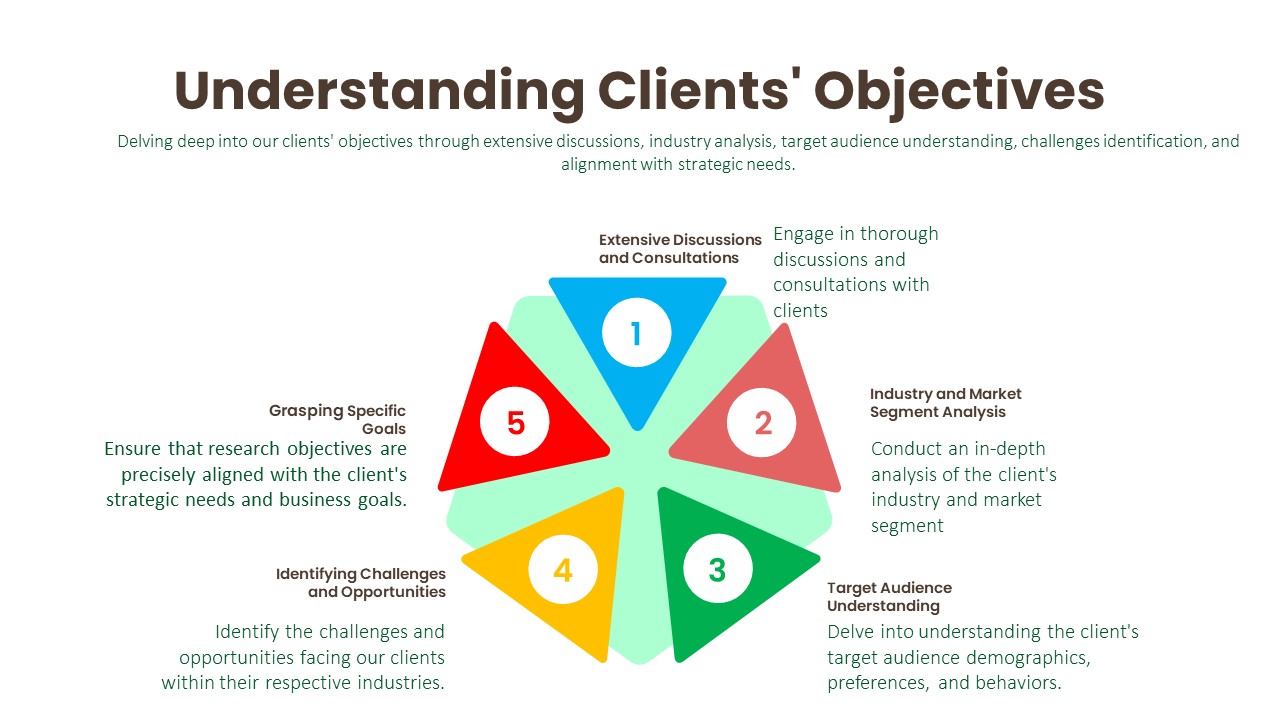
Identifying Challenges and Opportunities:
- We proactively identify the challenges and opportunities facing our clients within their respective industries. This involves conducting SWOT (Strengths, Weaknesses, Opportunities, Threats) analyses and competitive benchmarking exercises.
- By identifying potential obstacles and growth drivers, we can provide strategic recommendations that help our clients navigate complexities and capitalize on emerging opportunities effectively.
Grasping Specific Goals:
- We delve into the intricacies of our clients’ objectives to gain clarity on the specific goals they aim to accomplish through the research. This entails understanding their desired outcomes, such as market expansion, product development, or competitive analysis.
- By gaining a nuanced understanding of our clients’ goals, we can tailor our research approach to address their unique challenges and opportunities effectively.
Data Collection:
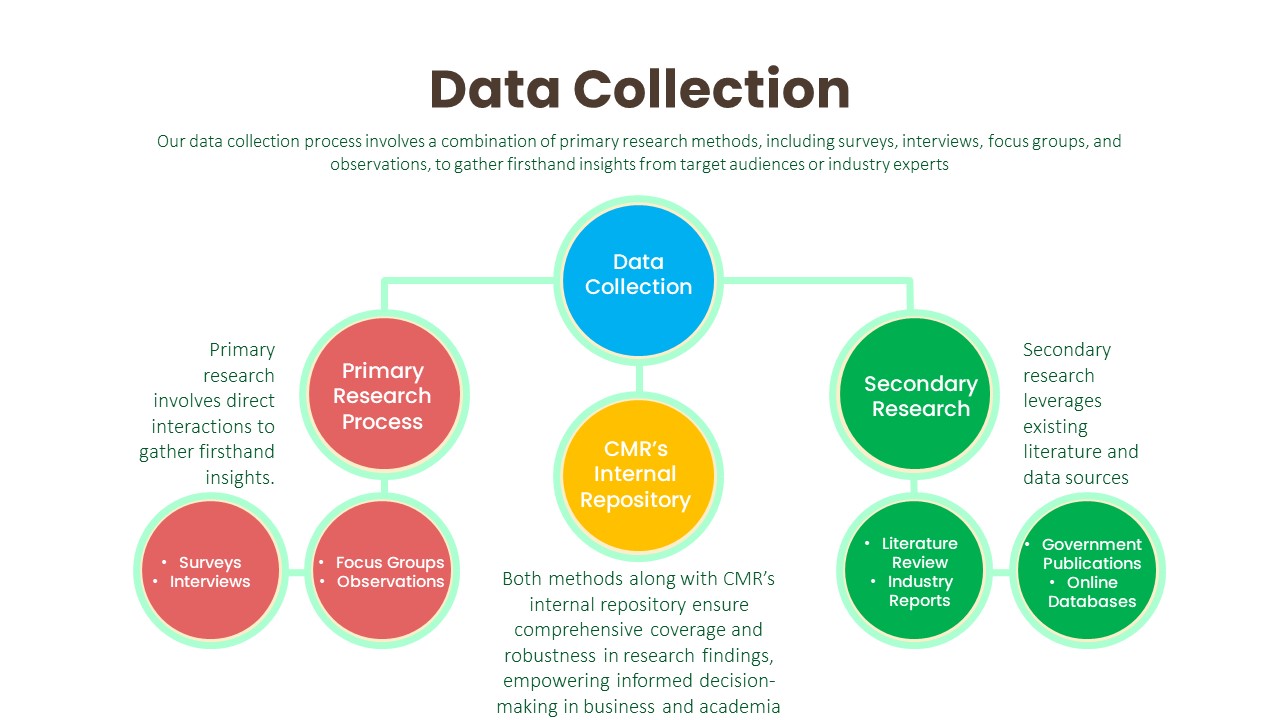
Primary Research Process:
- Surveys: We design and administer surveys tailored to capture specific information relevant to our clients’ objectives. This may involve employing various survey methodologies, such as online, telephone, or face-to-face interviews, to reach target audiences effectively.
- Interviews: We conduct structured or semi-structured interviews with key stakeholders, industry experts, or target consumers to gather in-depth insights and perspectives on relevant topics. These interviews allow us to probe deeper into specific issues and uncover valuable qualitative data.
- Focus Groups: We organize focus group discussions with carefully selected participants to facilitate interactive discussions and gather collective opinions, attitudes, and preferences. This qualitative research method provides rich contextual insights into consumer behaviors and perceptions.
- Observations: We conduct observational research by directly observing consumer behaviors, interactions, and experiences in real-world settings. This method enables us to gather objective data on consumer actions and reactions without relying on self-reported information.
Secondary Research Process:
- Literature Review: We conduct comprehensive literature reviews to identify existing studies, academic articles, and industry reports relevant to the research topic. This helps us gain insights into previous research findings, theoretical frameworks, and best practices.
- Industry Reports: We analyze industry reports published by reputable trade associations (whitepapers, research studies, etc.), and government agencies (U.S. Census Bureau, Bureau of Labor Statistics, and Securities and Exchange Commission etc.) to obtain macro-level insights into market trends, competitive landscapes, and industry dynamics.
- Government Publications: We review government publications, such as economic reports, regulatory documents, and statistical databases, to gather relevant data on demographics, market size, consumer spending patterns, and regulatory frameworks.
- Online Databases: We leverage online databases, such as industry portals, and academic repositories (PubMed Central (PMC), ScienceDirect, SSRN (Social Science Research Network), Directory of Open Access Journals (DOAJ), NCBI, etc.), to access a wide range of secondary data sources, including market statistics, financial data, and industry analyses.
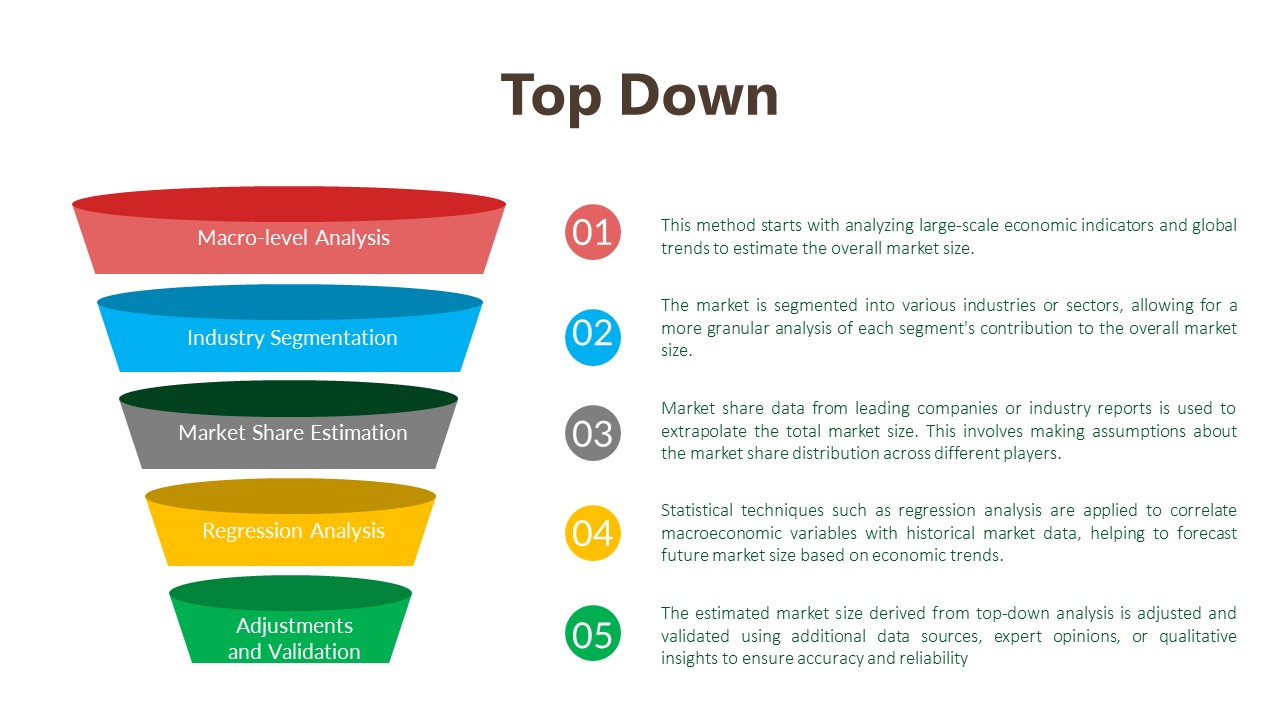
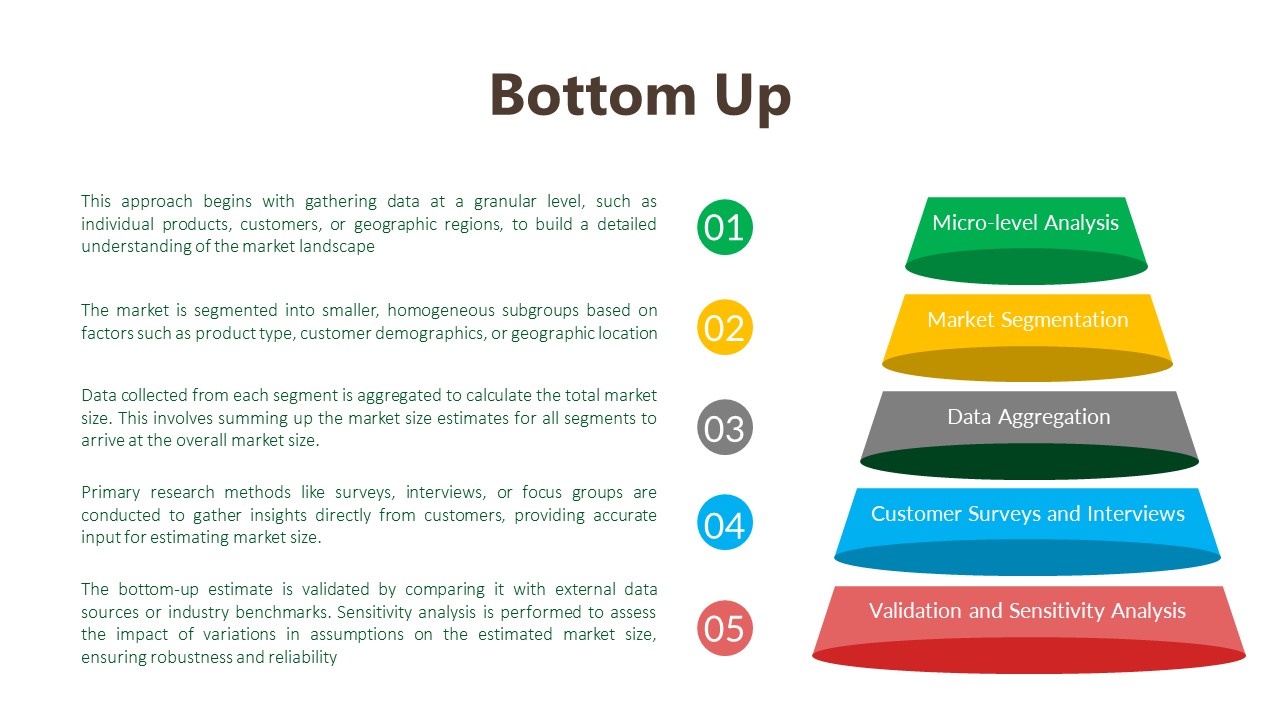
Data Analysis:
The data analysis phase serves as a critical juncture where raw data is transformed into actionable insights that inform strategic decision-making. Through the utilization of analytical methods such as statistical analysis and qualitative techniques like thematic coding, we uncover patterns, correlations, and trends within the data. By ensuring the integrity and validity of our findings, we strive to provide clients with accurate and reliable insights that accurately reflect the realities of the market landscape.

Transformation of Raw Data:
- Upon collecting the necessary data, we transition into the data analysis phase, where raw data is processed and transformed into actionable insights. This involves organizing, cleaning, and structuring the data to prepare it for analysis.
Utilization of Analytical Methods:
- Depending on the research objectives, we employ a diverse range of analytical methods to extract meaningful insights from the data. These methods include statistical analysis, trend analysis, regression analysis, and qualitative coding.
Statistical Analysis:
- Statistical tools are instrumental in uncovering patterns, correlations, and trends within the data. By applying statistical techniques such as descriptive statistics, hypothesis testing, and multivariate analysis, we can discern relationships and derive valuable insights.
Qualitative Analysis Techniques:
- In addition to quantitative analysis, we leverage qualitative analysis techniques to gain deeper insights from qualitative data sources such as interviews or open-ended survey responses. One such technique is thematic coding, which involves systematically categorizing and interpreting themes or patterns within qualitative data.
Integrity and Validity Maintenance:
- Throughout the analysis process, we maintain a steadfast commitment to upholding the integrity and validity of our findings. This entails rigorous adherence to established methodologies, transparency in data handling, and thorough validation of analytical outcomes.
Data Validation:
The final phase of our research methodology is data validation, which is essential for ensuring the reliability and credibility of our findings. Validation involves scrutinizing the collected data to identify any inconsistencies, errors, or biases that may have crept in during the research process. We employ various validation techniques, including cross-referencing data from multiple sources, conducting validity checks on survey instruments, and seeking feedback from independent experts or peer reviewers. Additionally, we leverage internal quality assurance protocols to verify the accuracy and integrity of our analysis. By subjecting our findings to rigorous validation procedures, we instill confidence in our clients that the insights they receive are robust, reliable, and trustworthy.
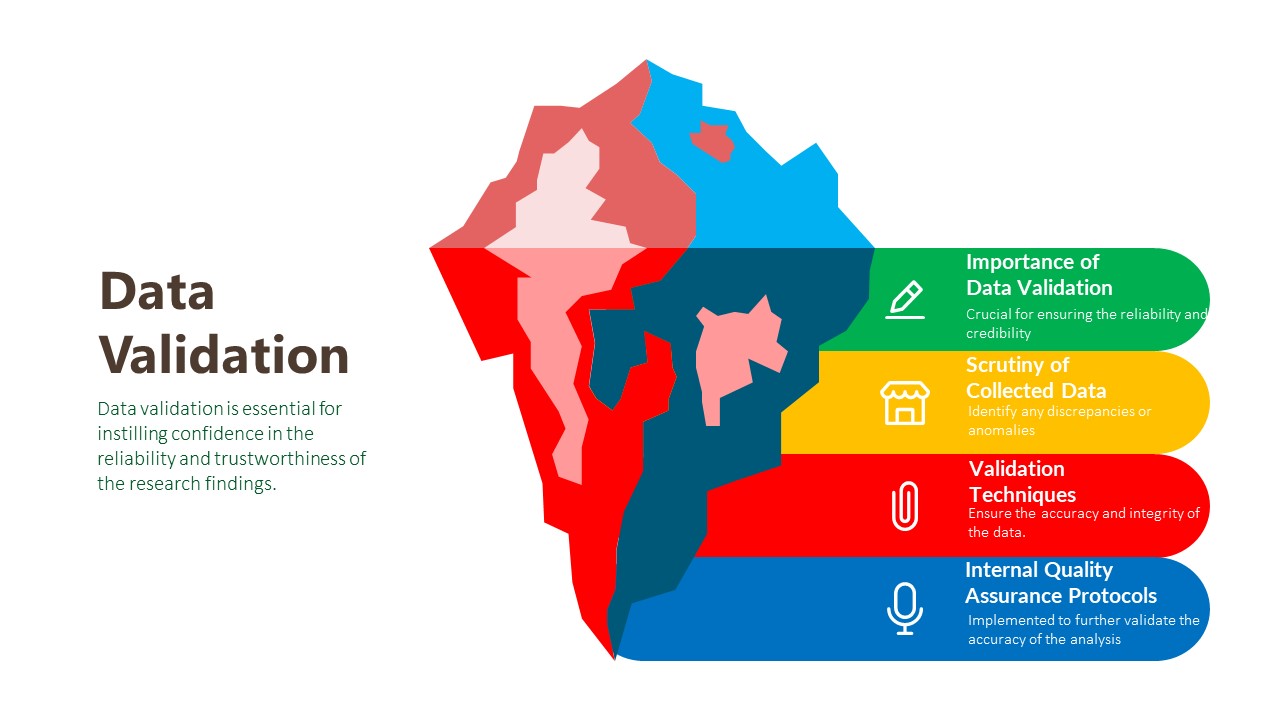
Importance of Data Validation:
- Data validation is the final phase of the research methodology, crucial for ensuring the reliability and credibility of the findings. It involves a systematic process of reviewing and verifying the collected data to detect any inconsistencies, errors, or biases.
Scrutiny of Collected Data:
- The validation process begins with a thorough scrutiny of the collected data to identify any discrepancies or anomalies. This entails comparing data points, checking for outliers, and verifying the accuracy of data entries against the original sources.
Validation Techniques:
- Various validation techniques are employed to ensure the accuracy and integrity of the data. These include cross-referencing data from multiple sources to corroborate findings, conducting validity checks on survey instruments to assess the reliability of responses, and seeking feedback from independent experts or peer reviewers to validate the interpretation of results.
Internal Quality Assurance Protocols:
- In addition to external validation measures, internal quality assurance protocols are implemented to further validate the accuracy of the analysis. This may involve conducting internal audits, peer reviews, or data validation checks to ensure that the research process adheres to established standards and guidelines.
We can customize every report – free of charge – including purchasing stand-alone sections or country-level reports
We help clients to procure the report or sections of the report at their budgeted price. Kindly click on the below to avail



